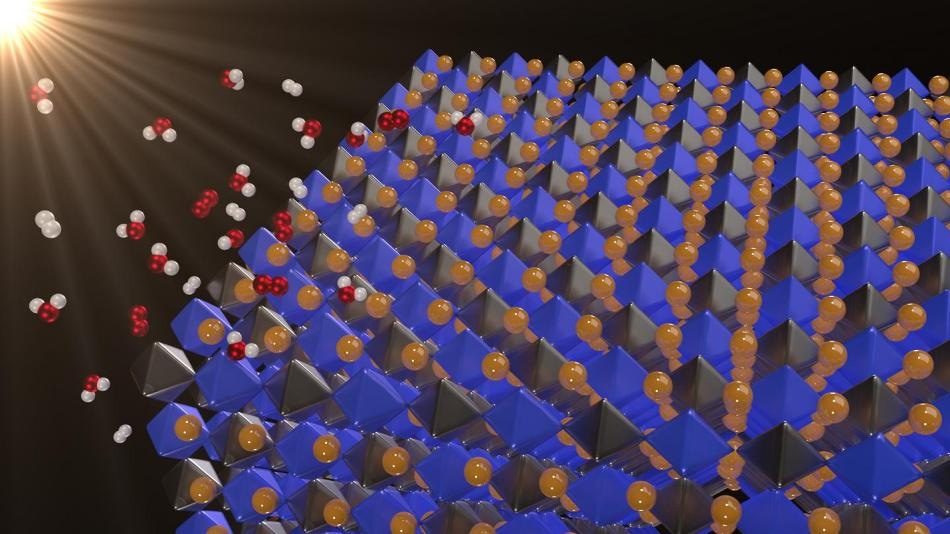Jun 21 2018
It is well known that solar energy is clean and available in large amounts, but when the sun is not shining one needs to store this energy in either batteries or through a process known as photocatalysis, wherein solar energy is used for making fuels.
 Solar energy is clean and abundant, but when the sun isn't shining, you must store the energy in batteries or through a process called photocatalysis. In photocatalytic water splitting, sunlight separates water into hydrogen and oxygen, which can then be recombined in a fuel cell to release energy. Now, a new class of materials -- halide double perovskites -- may have just the right properties to split water, according to research in Applied Physics Letters. In this image: Novel, lead-free double perovskites as potential photocatalysts for solar water splitting (Image credit: George Volonakis)
Solar energy is clean and abundant, but when the sun isn't shining, you must store the energy in batteries or through a process called photocatalysis. In photocatalytic water splitting, sunlight separates water into hydrogen and oxygen, which can then be recombined in a fuel cell to release energy. Now, a new class of materials -- halide double perovskites -- may have just the right properties to split water, according to research in Applied Physics Letters. In this image: Novel, lead-free double perovskites as potential photocatalysts for solar water splitting (Image credit: George Volonakis)
Sunlight separates water into oxygen and hydrogen during photocatalytic splitting of water. Subsequently, both oxygen and hydrogen can be again combined in a fuel cell to release energy.
Now, according to a recently published paper in Applied Physics Letters, from AIP Publishing, a new class of materials called halide double perovskites may possess the just right properties to capture solar energy and split water into oxygen and hydrogen.
"If we can come up with a material that can be useful as a water-splitting photocatalyst, then it would be an enormous breakthrough," stated the paper’s co-author Feliciano Giustino.
Scientists have already tested a number of photocatalytic materials, for example, titanium dioxide (TiO2). Although TiO2 can split water by harnessing sunlight, it is not efficient because it cannot adequately absorb visible light. To date, no commercial photocatalytic materials are available for general water splitting.
George Volonakis and Giustino, both from the University of Oxford, used supercomputers to compute the quantum energy states of four halide double perovskites and subsequently discovered that Cs2BiAgBr6 and Cs2BiAgCl6 are potential photocatalytic materials because when compared to TiO2 they absorb visible light much better. In addition, these materials create electrons and holes (the positively charges absence of electrons) that possess adequate energy (or almost ideal energies) to split water into oxygen and hydrogen.
Only some materials possess all these features simultaneously, Giustino said. "We can't say this will work for sure, but these compounds seem to have all the right properties."
This type of perovskite was originally discovered by Giustino and his group while they were looking for materials to develop solar cells. Over the last few years, perovskites have attracted a great deal of interest as materials that use tandem designs to increase the efficiency of silicon-based solar cells. These designs directly integrate a perovskite cell onto a high-efficiency silicon cell, but they also include a small quantity of lead. However, if they were employed for energy harvesting in solar farms, the lead may present a potential environmental hazard.
In 2016, the researchers used computer simulations to find alternative materials and they ultimately discovered a new kind of lead-free perovskite that shows promise for high-efficiency solar cells. The current paper reveals that these novel materials could possibly split water. "These new double perovskites are not only promising as a complementary material for tandem solar cells, but they can also be promising in areas like photocatalysis," Volonakis said.
Nevertheless, the latest analysis is hypothetical, assuming that perfect crystals are formed by the compounds. The authors said that it is now up to the experimentalists to see whether the new material also works equally well in the real world as predicted. Meanwhile, the research team is using its computational methods to explore if these double perovskites possess properties that are useful for other types of applications, like light detectors.